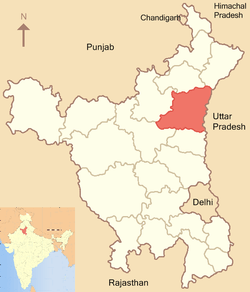Karnal district
| Karnal district करनाल जिला | |
|---|---|
| District of Haryana | |
 | |
| Country | India |
| State | Haryana |
| Administrative division | Rohtak |
| Headquarters | Karnal |
| Tehsils | 1. Karnal, 2. Nilokheri, 3. Indri, 4. Gharaunda, 5. Assandh |
| Government | |
| • Lok Sabha constituencies | Karnal (shared with Panipat district) |
| • Assembly seats | 5 |
| Area | |
| • Total | 1,967 km2 (759 sq mi) |
| Population (2001) | |
| • Total | 1,274,183 |
| • Density | 650/km2 (1,700/sq mi) |
| • Urban | 26.51% |
| Demographics | |
| • Literacy | 67.74% |
| Website | Official website |
Karnal district (Hindi: करनाल जिला) is one of the 21 districts of Haryana state in northern India. Karnal town is the administrative headquarters of the district. Other major towns in this district are Assandh, Gharaunda, Nilokheri, Indri and Jundla. This district is part of Rohtak Division.
History
Karnal district was one of the districts of Punjab state. It became one of the seven districts of Haryana state at the time of its inception on 1 November 1966. Later Kurukshetra district was separated from it on 23 January 1973, Kaithal district was separated from it on 1 November 1989. Panipat district was merged with it on 24 July 1991 but again separated from this district on 1 January 1992.
The origin of "Karnal" is Karnalaya, which means home of Karna. Karna is the popular character of Mahabharata.
Geography
Karnal district lies on the western bank of the river Yamuna, which forms its eastern boundary and separates Haryana from Uttar Pradesh. Karnal District, including Panipat, lies between 29 09' 50" and 29 50' North and 76 31' 15" and 77 12' 45" East; its height above sea level is around 240 meters. The district has an area of 1,967 km² and its population is 1,274,183 (2001 census). Karnal District is bordered by Kurukshetra District on its north-west, Jind & Kaithal Districts on its west, Panipat District on its south and Uttar Pradesh state on the east.
The district is a part of the Indus-Ganges plain and has a well-spread network of western Yamuna canals. Its geographical area has been divided into three agroclimatic regions: Khadar, Bangar and Nardak belt. Khadar starts from the Indri-Karnal road one mile away from Karnal covering the area between the Yamuna river and National Highway 1 up to Patti-Kalyana village. Bangar area starts from west of Khadar area covering Gharaunda development block. The Nardak area lies in Nissing, Nilokheri and Assandh development block. However, its water is saline and not fit for irrigation.
Divisions
Karnal district is divided into two sub-divisions: Karnal and Assandh. Karnal sub-division is divided into 4 tehsils: Karnal, Nilokheri, Indri and Gharaunda and 2 sub-tehsils: Nissing and Nigdu. Assandh sub-division comprises a lone tehsil, Assandh and a lone sub-tehsil, Ballah.
Demographics
According to the 2011 census Karnal district has a population of 1,506,323,[1] roughly equal to the nation of Gabon[2] or the US state of Hawaii.[3] This gives it a ranking of 333rd in India (out of a total of 640).[1] The district has a population density of 598 inhabitants per square kilometre (1,550 /sq mi) .[1] Its population growth rate over the decade 2001-2011 was 18.22%.[1] Karnal has a sex ratio of 886 females for every 1000 males,[1] and a literacy rate of 76.4%.[1] Hindi & Punjabi are major languages.
References
- ↑ 1.0 1.1 1.2 1.3 1.4 1.5 "District Census 2011". Census2011.co.in. 2011. Retrieved 2011-09-30.
- ↑ US Directorate of Intelligence. "Country Comparison:Population". Retrieved 2011-10-01. "Gabon 1,576,665"
- ↑ "2010 Resident Population Data". U. S. Census Bureau. Retrieved 2011-09-30. "Hawaii 1,360,301"
External links
 |
Kurukshetra district | Yamuna Nagar district Saharanpur district, Uttar Pradesh |
 | |
| Kaithal district | |
Shamli district, Uttar Pradesh | ||
| ||||
| | ||||
| Jind district | Panipat district |
| ||||||||||||||||||||||||||||||||||||||||||||||||||||||||||||||||||||||||
Coordinates: 29°40′N 76°50′E / 29.667°N 76.833°E